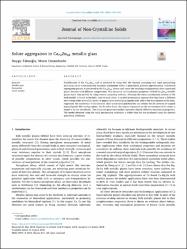Solute aggregation in Ca72Zn28metallic glass
Özet
Solidification of the Ca72Zn28 melt is achieved by using both the thermal quenching and rapid pressurizing techniques in ab initio molecular dynamics simulations within a generalized gradient approximation. A chemical segregation process is perceived in the Ca72Zn28 system and hence the resulting configurations show nanosized glassy domains with different compositions. The structural and mechanical properties of both Ca72Zn28 metallic glasses have been probed by using various analyzing methods. Although the mean coordination number of the both models is found to be fairly close to each other, a careful investigation exposes that they have a different short-range order around Zn atoms. It appears that pressurizing significantly affects the environment of Zn atom, suppresses the occurrence of Zn-centered ideal icosahedral polyhedrons and retains the Zn centered tri-capped trigonal prism–like configurations. On the other hand, the impact of pressure on the environment of Ca atoms is found to be not too drastic. The computer-generated models represent slightly different mechanical properties. The model obtained using the rapid pressurizing technique is stiffer than the one produced using the thermal quenching technique.


















